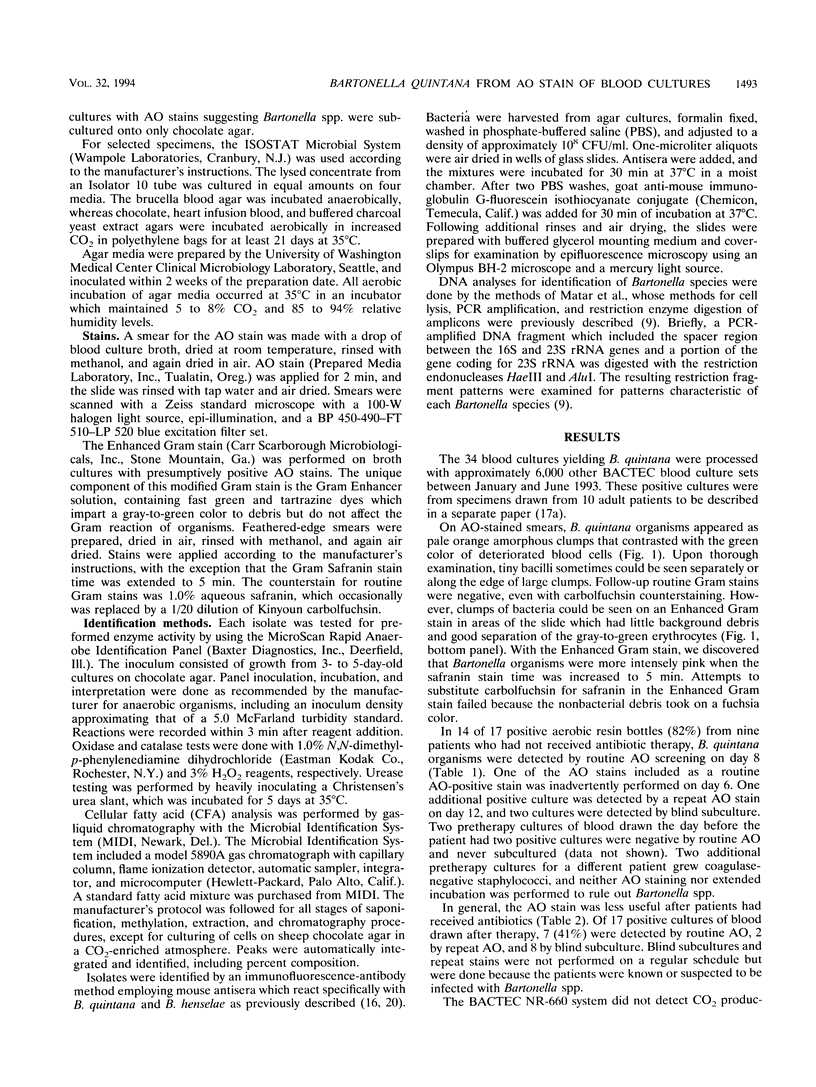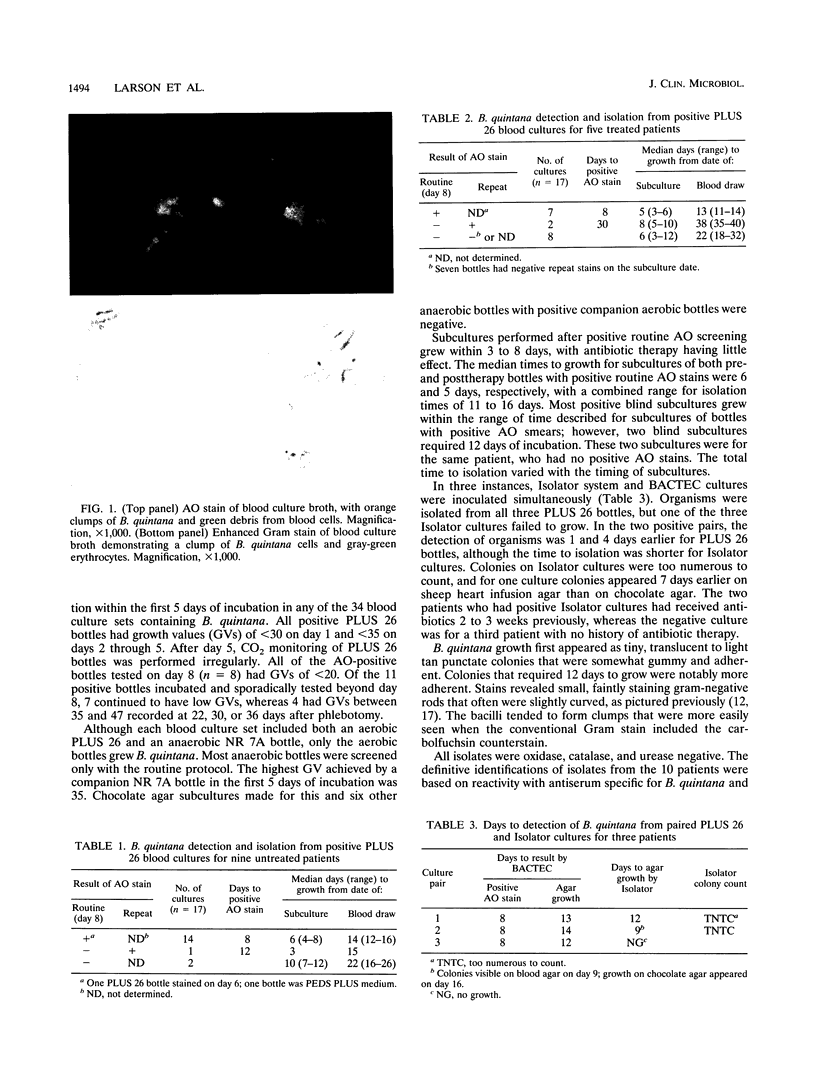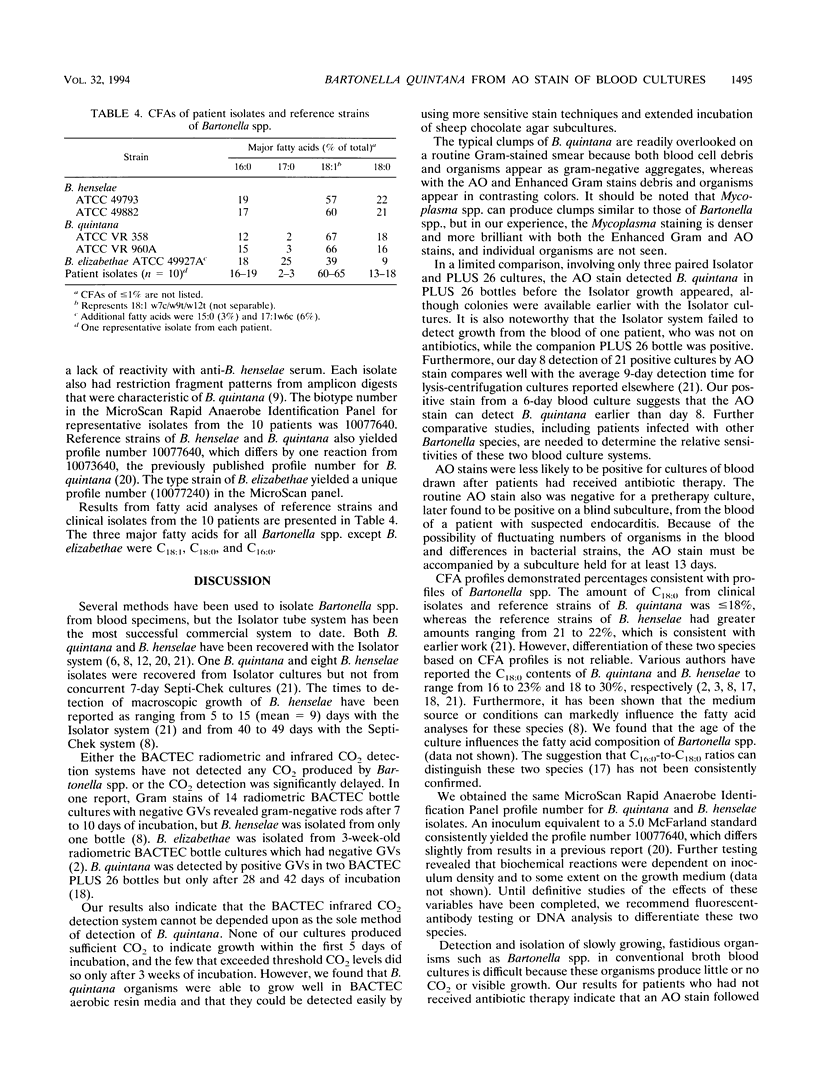Abstract
Bartonella quintana was isolated from 34 BACTEC nonradiometric aerobic resin blood cultures for 10 adults. Nine patients were initially diagnosed by routine acridine orange staining of routine cultures that had been incubated for 8 days. All subcultures grew on chocolate agar within 3 to 12 days (median, 6 days). The PLUS 26 high-volume aerobic resin medium, combined with acridine orange stain and subculture, is an effective system for detection and isolation of B. quintana from blood.
Full text
PDF




Images in this article
Selected References
These references are in PubMed. This may not be the complete list of references from this article.
- Brenner D. J., O'Connor S. P., Winkler H. H., Steigerwalt A. G. Proposals to unify the genera Bartonella and Rochalimaea, with descriptions of Bartonella quintana comb. nov., Bartonella vinsonii comb. nov., Bartonella henselae comb. nov., and Bartonella elizabethae comb. nov., and to remove the family Bartonellaceae from the order Rickettsiales. Int J Syst Bacteriol. 1993 Oct;43(4):777–786. doi: 10.1099/00207713-43-4-777. [DOI] [PubMed] [Google Scholar]
- Daly J. S., Worthington M. G., Brenner D. J., Moss C. W., Hollis D. G., Weyant R. S., Steigerwalt A. G., Weaver R. E., Daneshvar M. I., O'Connor S. P. Rochalimaea elizabethae sp. nov. isolated from a patient with endocarditis. J Clin Microbiol. 1993 Apr;31(4):872–881. doi: 10.1128/jcm.31.4.872-881.1993. [DOI] [PMC free article] [PubMed] [Google Scholar]
- Dolan M. J., Wong M. T., Regnery R. L., Jorgensen J. H., Garcia M., Peters J., Drehner D. Syndrome of Rochalimaea henselae adenitis suggesting cat scratch disease. Ann Intern Med. 1993 Mar 1;118(5):331–336. doi: 10.7326/0003-4819-118-5-199303010-00002. [DOI] [PubMed] [Google Scholar]
- Hunter J. S. Acridine orange staining as a replacement for subculturing of false-positive blood cultures with the BACTEC NR 660. J Clin Microbiol. 1993 Feb;31(2):465–466. doi: 10.1128/jcm.31.2.465-466.1993. [DOI] [PMC free article] [PubMed] [Google Scholar]
- Koehler J. E., Quinn F. D., Berger T. G., LeBoit P. E., Tappero J. W. Isolation of Rochalimaea species from cutaneous and osseous lesions of bacillary angiomatosis. N Engl J Med. 1992 Dec 3;327(23):1625–1631. doi: 10.1056/NEJM199212033272303. [DOI] [PubMed] [Google Scholar]
- Lauer B. A., Reller L. B., Mirrett S. Comparison of acridine orange and Gram stains for detection of microorganisms in cerebrospinal fluid and other clinical specimens. J Clin Microbiol. 1981 Aug;14(2):201–205. doi: 10.1128/jcm.14.2.201-205.1981. [DOI] [PMC free article] [PubMed] [Google Scholar]
- Lucey D., Dolan M. J., Moss C. W., Garcia M., Hollis D. G., Wegner S., Morgan G., Almeida R., Leong D., Greisen K. S. Relapsing illness due to Rochalimaea henselae in immunocompetent hosts: implication for therapy and new epidemiological associations. Clin Infect Dis. 1992 Mar;14(3):683–688. doi: 10.1093/clinids/14.3.683. [DOI] [PubMed] [Google Scholar]
- Matar G. M., Swaminathan B., Hunter S. B., Slater L. N., Welch D. F. Polymerase chain reaction-based restriction fragment length polymorphism analysis of a fragment of the ribosomal operon from Rochalimaea species for subtyping. J Clin Microbiol. 1993 Jul;31(7):1730–1734. doi: 10.1128/jcm.31.7.1730-1734.1993. [DOI] [PMC free article] [PubMed] [Google Scholar]
- McCarthy L. R., Senne J. E. Evaluation of acridine orange stain for detection of microorganisms in blood cultures. J Clin Microbiol. 1980 Mar;11(3):281–285. doi: 10.1128/jcm.11.3.281-285.1980. [DOI] [PMC free article] [PubMed] [Google Scholar]
- Mirrett S., Lauer B. A., Miller G. A., Reller L. B. Comparison of acridine orange, methylene blue, and Gram stains for blood cultures. J Clin Microbiol. 1982 Apr;15(4):562–566. doi: 10.1128/jcm.15.4.562-566.1982. [DOI] [PMC free article] [PubMed] [Google Scholar]
- Regnery R. L., Anderson B. E., Clarridge J. E., 3rd, Rodriguez-Barradas M. C., Jones D. C., Carr J. H. Characterization of a novel Rochalimaea species, R. henselae sp. nov., isolated from blood of a febrile, human immunodeficiency virus-positive patient. J Clin Microbiol. 1992 Feb;30(2):265–274. doi: 10.1128/jcm.30.2.265-274.1992. [DOI] [PMC free article] [PubMed] [Google Scholar]
- Relman D. A., Loutit J. S., Schmidt T. M., Falkow S., Tompkins L. S. The agent of bacillary angiomatosis. An approach to the identification of uncultured pathogens. N Engl J Med. 1990 Dec 6;323(23):1573–1580. doi: 10.1056/NEJM199012063232301. [DOI] [PubMed] [Google Scholar]
- Schwartzman W. A. Infections due to Rochalimaea: the expanding clinical spectrum. Clin Infect Dis. 1992 Dec;15(6):893–900. doi: 10.1093/clind/15.6.893. [DOI] [PubMed] [Google Scholar]
- Slater L. N., Coody D. W., Woolridge L. K., Welch D. F. Murine antibody responses distinguish Rochalimaea henselae from Rochalimaea quintana. J Clin Microbiol. 1992 Jul;30(7):1722–1727. doi: 10.1128/jcm.30.7.1722-1727.1992. [DOI] [PMC free article] [PubMed] [Google Scholar]
- Slater L. N., Welch D. F., Hensel D., Coody D. W. A newly recognized fastidious gram-negative pathogen as a cause of fever and bacteremia. N Engl J Med. 1990 Dec 6;323(23):1587–1593. doi: 10.1056/NEJM199012063232303. [DOI] [PubMed] [Google Scholar]
- Spach D. H., Callis K. P., Paauw D. S., Houze Y. B., Schoenknecht F. D., Welch D. F., Rosen H., Brenner D. J. Endocarditis caused by Rochalimaea quintana in a patient infected with human immunodeficiency virus. J Clin Microbiol. 1993 Mar;31(3):692–694. doi: 10.1128/jcm.31.3.692-694.1993. [DOI] [PMC free article] [PubMed] [Google Scholar]
- Varela G., Vinson J. W., Molina-Pasquel C. Trench fever. II. Propagation of Rickettsia quintana on cell-free medium from the blood of two patients. Am J Trop Med Hyg. 1969 Sep;18(5):708–712. [PubMed] [Google Scholar]
- Welch D. F., Hensel D. M., Pickett D. A., San Joaquin V. H., Robinson A., Slater L. N. Bacteremia due to Rochalimaea henselae in a child: practical identification of isolates in the clinical laboratory. J Clin Microbiol. 1993 Sep;31(9):2381–2386. doi: 10.1128/jcm.31.9.2381-2386.1993. [DOI] [PMC free article] [PubMed] [Google Scholar]
- Welch D. F., Pickett D. A., Slater L. N., Steigerwalt A. G., Brenner D. J. Rochalimaea henselae sp. nov., a cause of septicemia, bacillary angiomatosis, and parenchymal bacillary peliosis. J Clin Microbiol. 1992 Feb;30(2):275–280. doi: 10.1128/jcm.30.2.275-280.1992. [DOI] [PMC free article] [PubMed] [Google Scholar]
- Zangwill K. M., Hamilton D. H., Perkins B. A., Regnery R. L., Plikaytis B. D., Hadler J. L., Cartter M. L., Wenger J. D. Cat scratch disease in Connecticut. Epidemiology, risk factors, and evaluation of a new diagnostic test. N Engl J Med. 1993 Jul 1;329(1):8–13. doi: 10.1056/NEJM199307013290102. [DOI] [PubMed] [Google Scholar]



